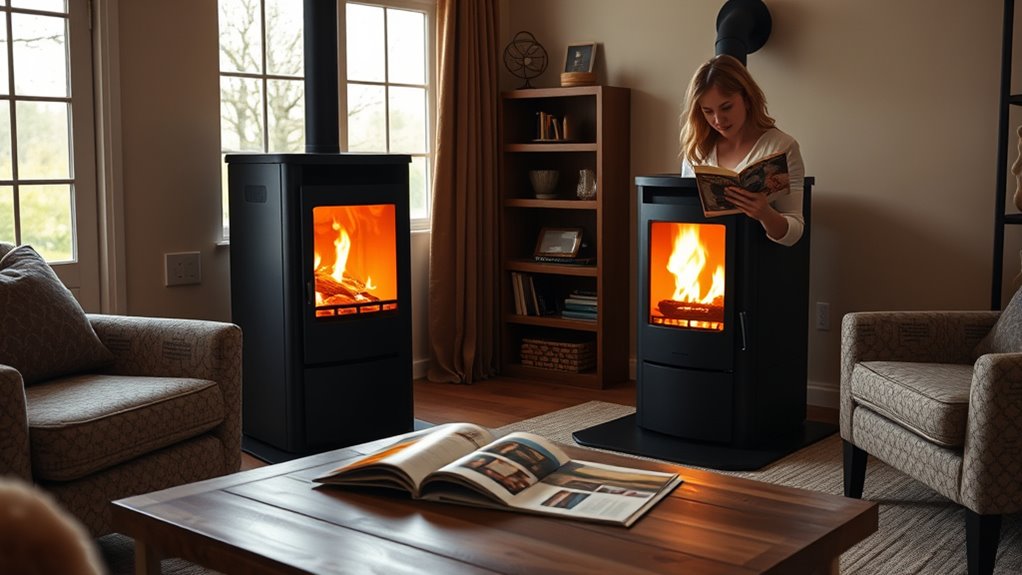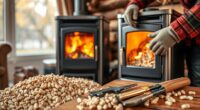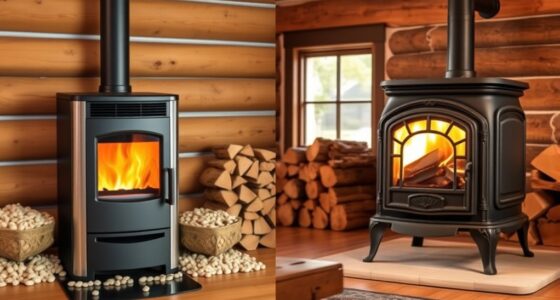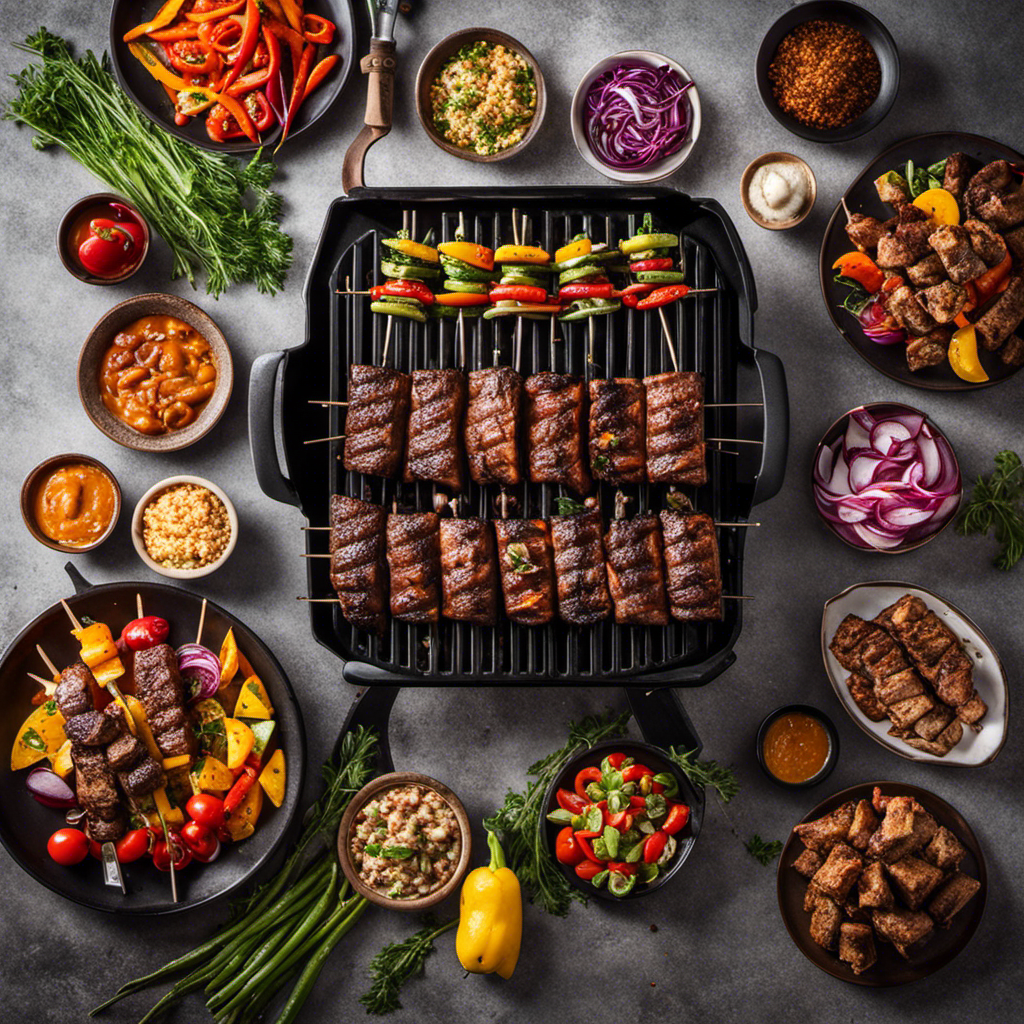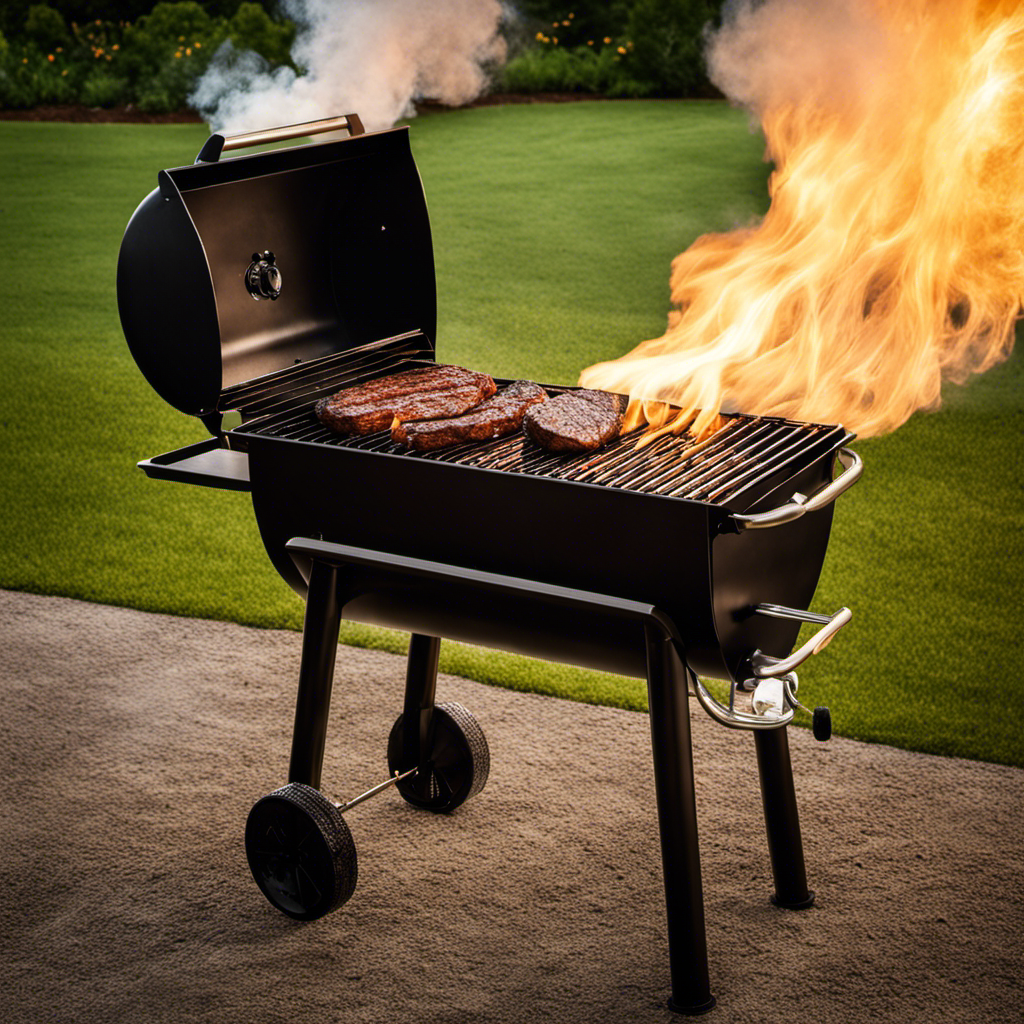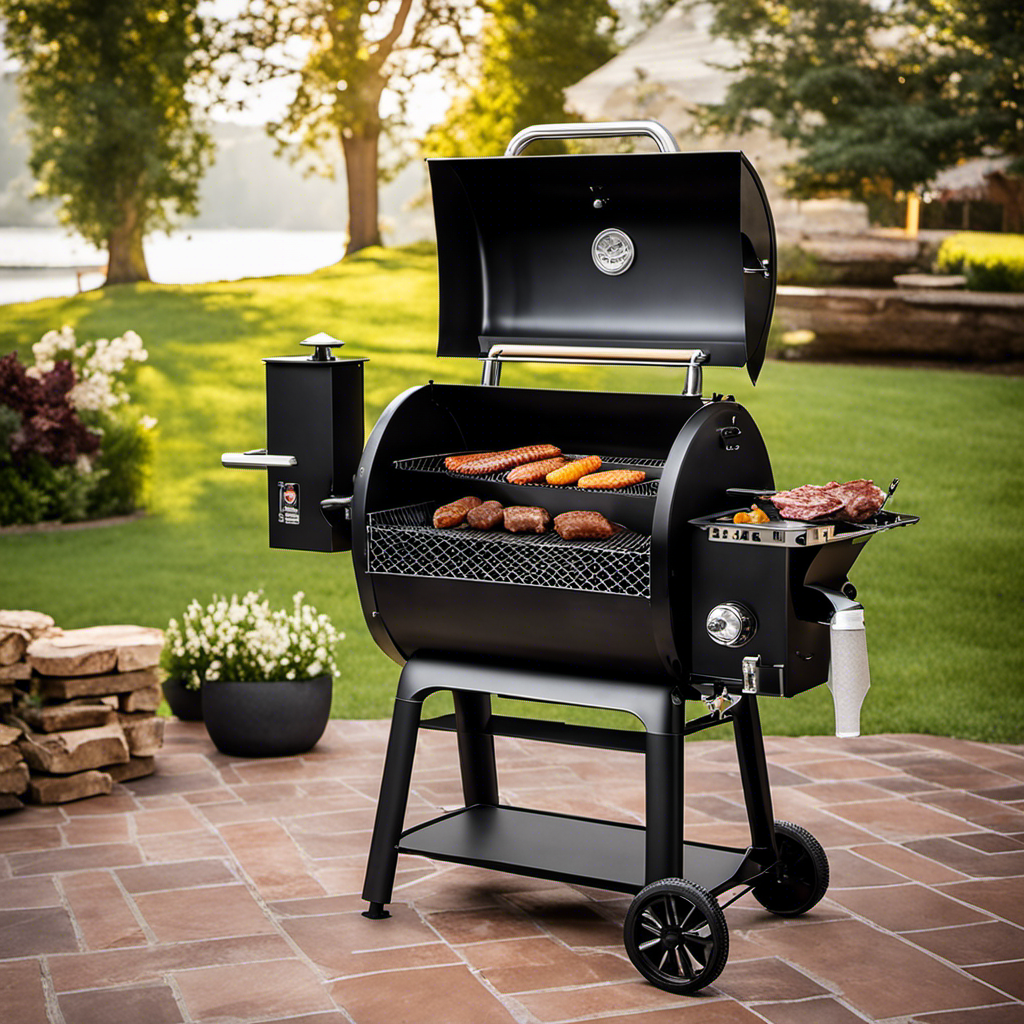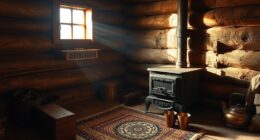To choose the right pellet stove, start by evaluating your home’s size and heating needs, ensuring the stove’s BTU output matches those requirements. Consider your space for installation and proper venting, select a model with an appropriate hopper size to suit your fueling habits, and look for features like adjustable controls for efficiency. Research trusted brands and check warranties to guarantee support. For a smoother purchase, explore detailed tips that help you make an informed decision.
Key Takeaways
- Determine your home’s square footage and BTU needs to select an appropriately sized stove.
- Choose between freestanding or insert models based on installation space and existing fireplace setup.
- Consider stove features like digital controls, smart connectivity, and adjustable fan settings for convenience.
- Match the stove’s style, finish, and color to your home decor for aesthetic harmony.
- Review warranties, installation costs, and available incentives to make an informed, cost-effective purchase.
Assess Your Heating Needs and Home Layout
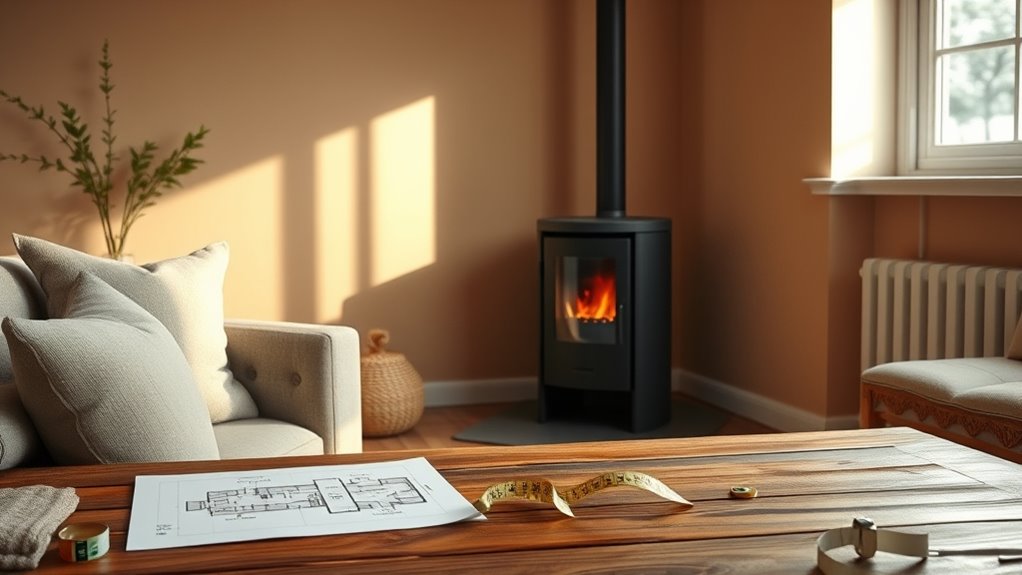
To choose the right pellet stove, you need to start by evaluating your heating needs and home layout. First, determine the square footage of the area you want to heat—most pellet stoves cover between 500 and 2,500 square feet, with BTU outputs from 30,000 to 50,000. Consider your home’s insulation and draft levels; well-insulated homes retain heat better, so you might need a lower BTU stove. Decide if the pellet stove will be your primary heat source or supplemental; this influences the size and features you should select. Also, think about your home’s layout and the number of rooms to be heated, ensuring the stove’s heat distribution aligns with your home’s design. This initial assessment helps you find a stove that fits your specific heating needs. Additionally, understanding the performance capabilities of different pellet stoves can help you make an informed decision, especially since factors like cost and efficiency vary widely depending on design and build quality.
Understand Different Types of Pellet Stoves
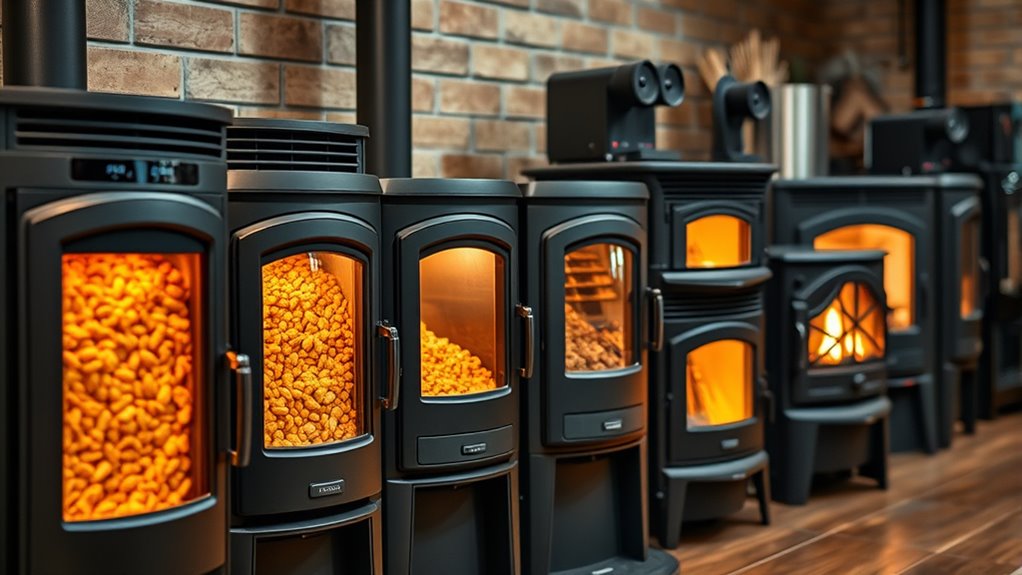
Pellet stoves come mainly as freestanding units or as inserts designed for existing fireplaces. Freestanding models can be placed almost anywhere with proper venting, while inserts fit into chimneys for better efficiency. Your choice depends on your home’s setup, space, and aesthetic preferences. Considering the variety of pellet stove types, it’s important to assess which model best suits your heating needs and installation requirements. Additionally, understanding the energy efficiency of different models can help you make a more informed decision. For optimal operation, evaluating installation requirements can ensure safe and effective heating while also considering smart features that enhance user convenience. Moreover, some models are designed to accommodate home heating systems, providing integrated solutions for whole-house warmth.
Free-standing vs. Insert Units
When choosing between free-standing and insert pellet stoves, understanding their differences helps you make the right decision for your home. Free-standing pellet stoves are self-contained units that can be placed anywhere with proper venting, offering flexibility and larger capacities for bigger spaces. Pellet inserts fit into existing fireplaces, using the chimney for venting and maintaining a traditional look. They’re ideal for upgrading your current setup and improving efficiency. Here’s a quick comparison:
| Feature | Free-standing Pellet Stove | Pellet Inserts | Venting |
|---|---|---|---|
| Placement | Anywhere, flexible | Fireplace-specific | Separate or chimney |
| Capacity & Heat | Larger, greater output | Suitable for smaller spaces | Integrated with setup |
| Aesthetic | Modern standalone design | Preserves fireplace look | Varies by installation |
| Installation | Easier, portable | Requires existing fireplace | Needs proper venting |
Additionally, understanding the venting options available ensures proper installation and safety. Proper venting design is essential to prevent emissions and ensure efficient operation. Moreover, selecting the right venting components can simplify the installation process and enhance the stove’s performance. Properly designed venting systems can also help extend the lifespan of your pellet stove by preventing buildup and corrosion. For optimal performance, it’s important to consider the venting system that best matches your specific stove model and installation environment.
Venting and Installation Needs
Choosing the right venting method is vital to installing your pellet stove safely and efficiently. Your venting options include horizontal pipes through exterior walls or vertical pipes through the roof. Each requires proper sealing and clearance to prevent leaks and guarantee safety. Fireplace inserts typically vent through existing chimneys, which may need lining or modifications to meet current safety standards. Freestanding pellet stoves usually vent directly outside via a single 4-inch pipe, simplifying installation and reducing costs. It’s essential to follow local building codes and manufacturer guidelines during installation to prevent dangerous carbon monoxide buildup and optimize performance. Selecting appropriate venting materials, like stainless steel or aluminum pipes, based on your stove type and venting direction, and conducting regular inspections, will maintain safety and efficiency over time. Proper venting is especially important given AI security concerns related to combustion safety and system monitoring. Ensuring your venting system is free of blockages and leaks can also help prevent venting issues, maintaining a safe environment in your home. Additionally, understanding the different venting configurations can help you choose the best setup for your specific needs. Incorporating proper installation techniques and consulting with a professional installer who is familiar with local building codes and pellet stove regulations will further enhance safety and performance.
Determine the Appropriate Heating Capacity (BTUs)
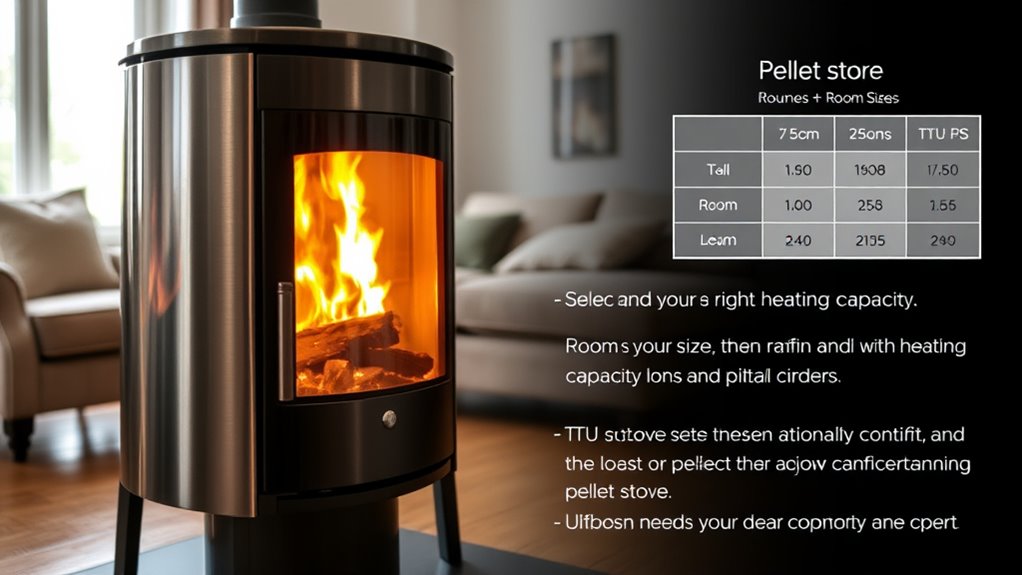
To determine the right heating capacity for your pellet stove, start by calculating your home’s BTU needs based on its size and insulation. Multiply your square footage by 25-30 BTUs per square foot, adjusting for climate and insulation quality. For example, a 1,500 sq ft home in a moderate climate typically requires a stove with a capacity of 37,500 to 45,000 BTUs. Check the stove’s heat output rating in BTUs/hour to guarantee it can adequately warm your space. A model with around 40,000 BTUs/hour usually heats 1,500–2,000 sq ft. Remember, an oversized stove can cause overheating, while an undersized one may struggle to maintain consistent warmth. Consider ceiling height and insulation to refine your BTU calculation for ideal comfort. Additionally, understanding your home’s heat loss factors can help ensure you select a pellet stove that provides efficient and reliable heating. Incorporating energy efficiency ratings into your evaluation can further optimize your choice for cost-effective operation. Being aware of the various stove styles available can also help you choose a model that best fits your aesthetic and functional preferences. Moreover, assessing your household’s dynamic heat requirements can help you select a stove that adapts well to fluctuating heating demands. Evaluating ventilation and exhaust options is also crucial for safe and effective operation of your pellet stove.
Evaluate Space for Installation and Venting
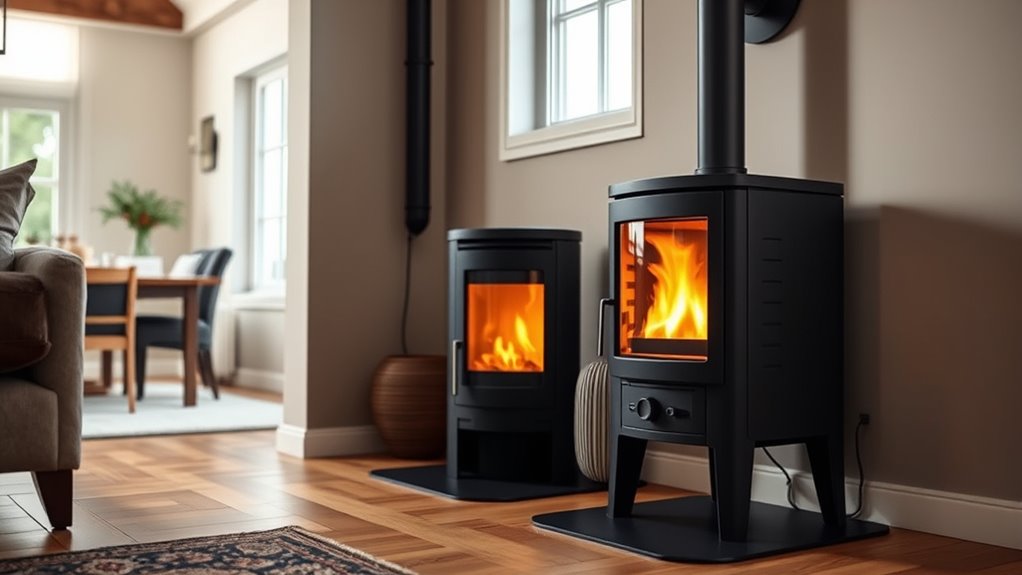
Evaluating your space for pellet stove installation involves ensuring proper venting, clearance, and accessibility. You need a suitable exterior wall or roof space for venting, as most pellet stoves require a 4-inch vent pipe for exhaust. Make sure the location provides enough clearance from combustible materials—usually 1-3 inches for modern stoves—to meet safety standards. Confirm there’s easy access to a power outlet, since pellet stoves rely on electricity for operation. Consider proximity to a reliable pellet supply and how easily you can perform maintenance. Additionally, ensure the space allows for adequate airflow from the blower, so heat distributes efficiently throughout the room. Proper planning at this stage prevents future issues and guarantees safe, effective installation. Since proper venting and safety protocols are essential, understanding hydrogen safety can help prevent potential hazards related to combustion and storage. Ensuring proper ventilation also helps prevent carbon monoxide buildup, which is crucial for safe operation. Evaluating your space with attention to ventilation requirements is vital to maintain safety and efficiency in your pellet stove system. Additionally, verifying that the space adheres to safety standards will further promote safe usage and compliance with local regulations.
Consider Hopper Size and Fueling Frequency
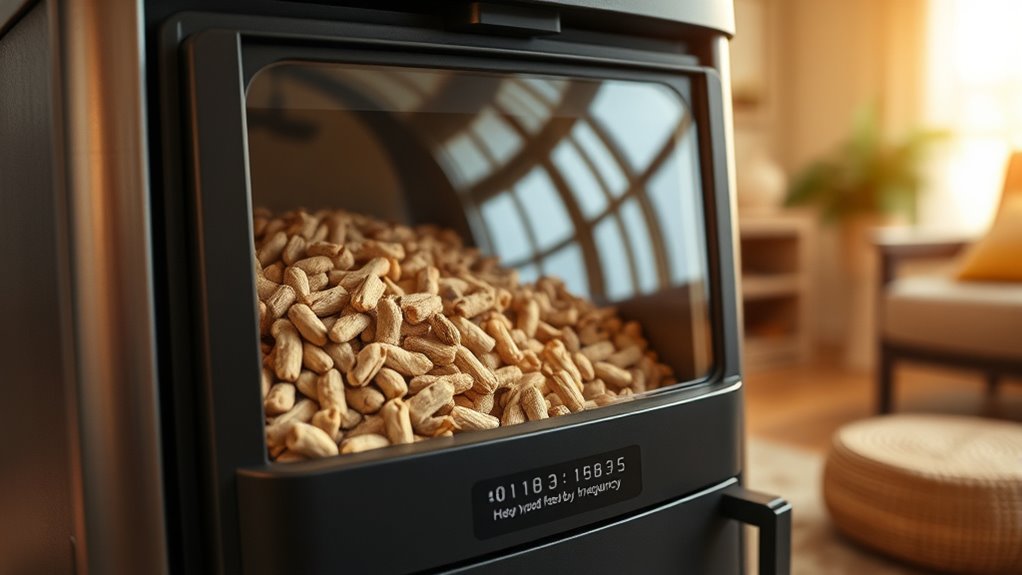
Considering hopper size is essential for ensuring your pellet stove fits your heating needs and lifestyle. A larger hopper, such as 40 pounds or more, offers longer intervals between refills—up to three days of continuous use—reducing the hassle of frequent fueling. Conversely, smaller hoppers around 20 pounds may require daily refilling, especially during cold spells, which can be inconvenient if you prefer less maintenance. The fueling frequency depends on your stove’s burn rate, influenced by BTU output, pellet quality, and thermostat settings. By choosing a stove with an appropriate pellet capacity, you can balance convenience and storage, ensuring consistent heat while avoiding the inconvenience of frequent refills or excess stored pellets. Think about your daily pellet consumption habits to find the right fit.
Choose a Style and Aesthetic Fit for Your Home
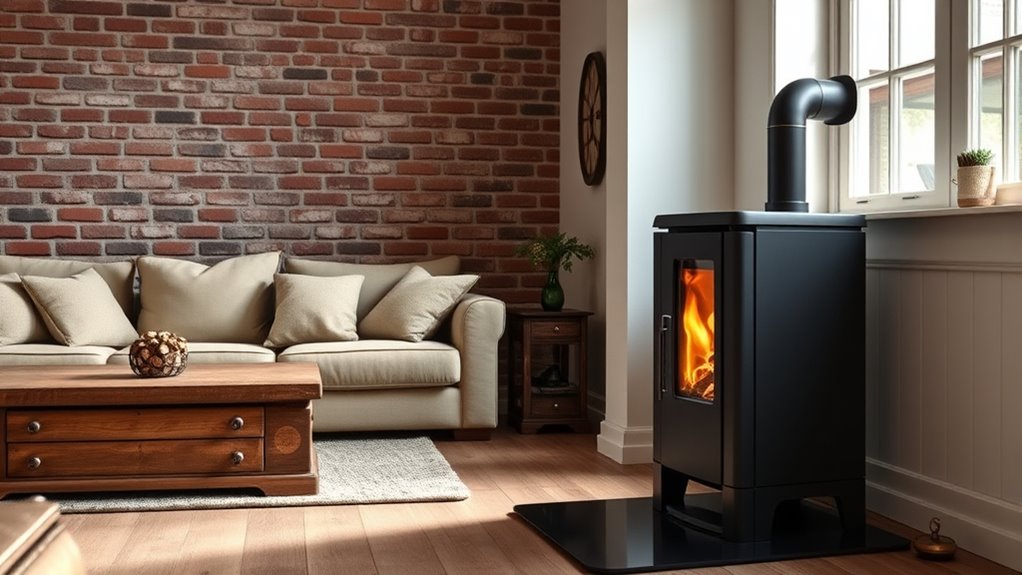
When selecting a pellet stove, matching its style and appearance to your home’s design creates a cohesive and inviting space. Consider how the stove’s overall design complements your decor, whether you prefer a sleek modern look or a traditional, ornate style. The appearance of the stove can enhance your room’s ambiance and reflect your personal taste.
- Choose from traditional, modern, or European styles to suit your home’s design
- Opt for customizable finishes like cast iron or enamel for durability and visual appeal
- Select the right size and shape to harmonize with your room’s proportions
- Consider color options that coordinate with your interior palette
Matching your stove’s style and appearance ensures it seamlessly integrates into your home’s aesthetic.
Review Features and Controls for Efficiency and Convenience
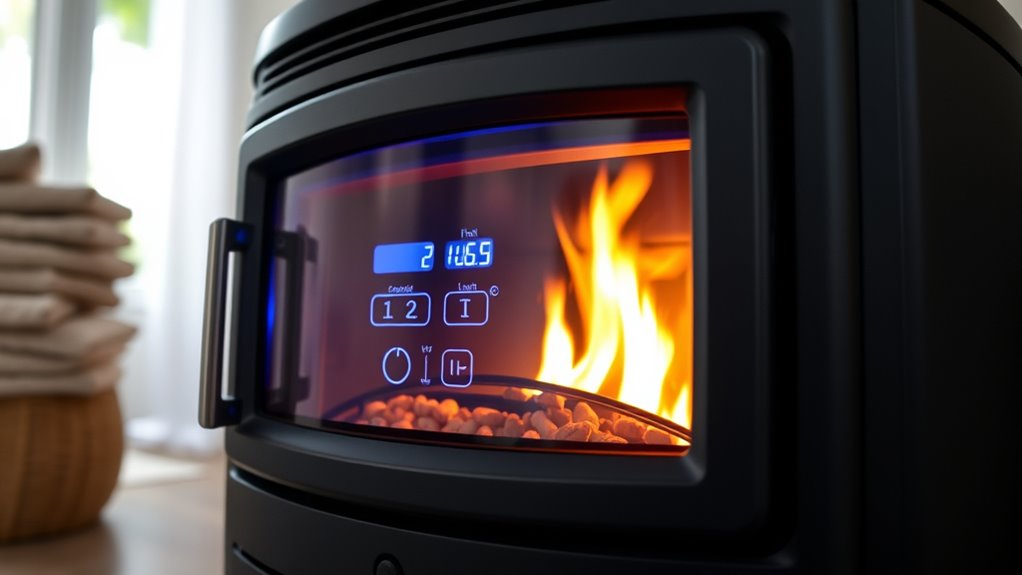
To guarantee your pellet stove operates efficiently and conveniently, it’s vital to review its features and control options carefully. Look for models with digital displays for easy operation and diagnostics, making troubleshooting straightforward. A programmable thermostat allows you to set and maintain preferred temperatures effortlessly, saving energy. Smart controls enable scheduling and real-time monitoring, adding convenience and efficiency. Adjustable fan speeds and heat output settings help customize comfort and optimize performance. User-friendly interfaces, such as touchscreens or simple button panels, simplify programming and daily use. Consider the following features to enhance your experience:
| Feature | Benefit |
|---|---|
| Digital display | Easy operation, troubleshooting |
| Programmable thermostat | Precise temperature control |
| Smart controls | Scheduling, remote monitoring |
| Adjustable fan speeds | Customized comfort |
| User-friendly interface | Simplifies operation and programming |
Research Reliable Brands and Models
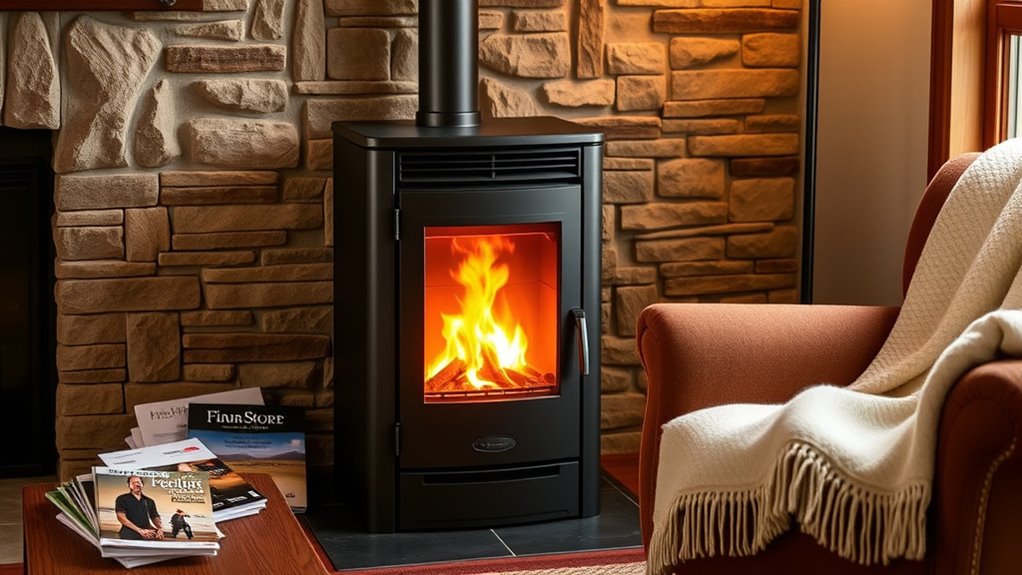
Choosing a reliable brand is key to ensuring your pellet stove performs well and lasts for years. Top industry leaders like Harman, Quadra-Fire, and Enviro offer models with strong warranties, good support, and proven efficiency. Research their features, customer reviews, and warranty coverage to find the best fit for your needs.
Top Industry Leaders
Leading brands in the pellet stove industry have earned their reputation through innovation, durability, and efficiency. As you explore options, focus on industry leaders known for high performance and reliable features. Harman stands out with models offering advanced temperature controls, diagnostics, and EPA compliance, ensuring efficiency and long-term savings. Quadra-Fire is renowned for durable designs and consistent performance, making it a trusted choice. Italian brands like Piazzetta and Ravelli deliver sleek aesthetics with efficiency ratings over 80%, perfect for stylish homes. Additionally, Enviro provides budget-friendly options without sacrificing efficiency, ideal if you’re mindful of costs. Reputable brands also back their products with extensive warranties and certified installation, giving you peace of mind on your investment.
Efficiency and Features
When evaluating pellet stoves, focusing on efficiency and features helps guarantee you select a reliable model that meets your needs. Look for brands like Harman, Quadra-Fire, and Piazzetta, which offer stoves with efficiencies over 80%, ensuring you get ideal heat with less fuel. High-quality models include automated features like Wi-Fi connectivity, programmable thermostats, and smart sensors, making heat regulation seamless and convenient. Durable materials such as cast iron and premium steel not only boost longevity but also improve heat retention, enhancing overall efficiency. Many top models also feature self-cleaning systems, automated ash removal, and diagnostic alerts, reducing maintenance and increasing reliability. Always verify efficiency ratings (preferably ≥75% HHV) and warranty coverage when researching brands for dependable long-term operation.
Warranty and Support
Ever wonder which pellet stove brands stand out for their warranty and support? Reputable brands like Harman, Quadra-Fire, and Piazzetta offer extensive warranties from 1 to 5 years, covering parts and labor. Choosing brands with authorized dealer networks guarantees reliable support, genuine replacement parts, and professional repairs. Higher-end models often include extended warranties and superior customer service, providing peace of mind for long-term reliability. To guarantee you’re making a smart investment, consider these factors:
- Look for brands with strong warranty coverage and clear policies
- Verify authorized dealer and service networks
- Read customer reviews on support responsiveness
- Choose models with certified installers for ongoing maintenance
These steps help ensure your stove’s support and warranty keep your home warm and worry-free.
Factor in Installation Costs and Requirements
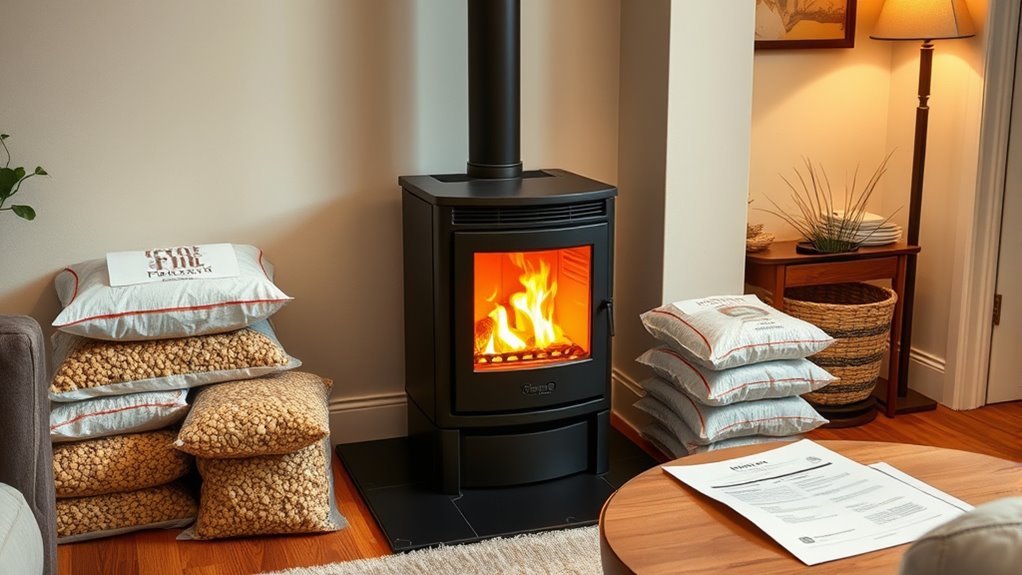
Installing a pellet stove involves careful consideration of costs and requirements to guarantee safety and efficiency. First, evaluate installation costs, which typically range from $1,000 to $3,500, depending on your home’s layout and the stove model. Proper venting is vital; options include horizontal pipes through exterior walls or vertical pipes through the roof, with costs varying based on pipe length, material, and complexity. You’ll also need to account for electrical connections—most models require a dedicated 110V or 220V outlet, and backup power systems might be necessary. Professional installation is highly recommended to ensure proper venting, electrical hookup, and clearance compliance. Remember, permits may be required, adding to the overall expenses but ensuring safety and code adherence.
Explore Incentives, Warranties, and Support Options
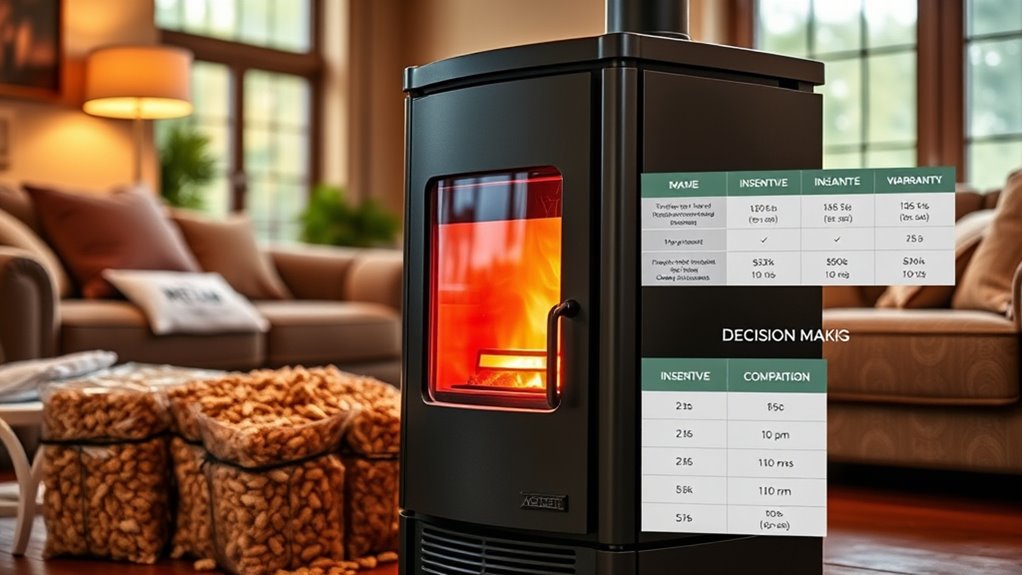
Considering the investment involved in installing a pellet stove, it’s important to also examine the support options and financial incentives available. Many high-efficiency pellet stoves qualify for up to a 30% federal tax credit, considerably cutting your overall cost. Reputable dealers often offer warranties ranging from 1 to 5 years, giving you peace of mind for parts and labor. Certified installers can provide support through proper setup, maintenance, and troubleshooting during the warranty period. Choosing brands with established support networks and readily available replacement parts makes repairs easier and extends your stove’s lifespan. Additionally, some manufacturers offer dedicated customer service hotlines, online resources, and extended warranties to assist you after purchase. These incentives, warranties, and support options help you make a confident, informed decision.
Frequently Asked Questions
What Size Pellet Burner Do I Need for My House?
To find the right pellet stove size for your house, start by calculating your home’s square footage. You’ll need about 20 BTUs per square foot for moderate insulation. For example, a 1,500 sq ft home needs a stove with roughly 30,000 BTUs. Check the stove’s specifications to guarantee it covers your space comfortably without overheating, and consider your home’s insulation and layout for ideal heating efficiency.
How Big of a Pellet Stove Do I Need for a 2000 Square-Foot House?
You’re wondering how big of a pellet stove you need for your 2,000-square-foot home. Generally, a stove with a capacity of 40,000 to 50,000 BTUs functions well, assuming average insulation and climate. Keep in mind, if your home is poorly insulated or has many windows, you might need a slightly higher capacity. It’s best to consult manufacturer guidelines or a heating professional to guarantee the perfect fit.
What to Know Before Buying a Pellet Stove?
When buying a pellet stove, you need to consider both your home’s needs and your lifestyle. Think about the size, efficiency, and emissions to find a model that heats effectively without harming the environment. Balance convenience with capacity by choosing a hopper size that suits your refill habits. Research reputable brands with good warranties and support, ensuring your investment lasts and performs well for years to come.
Why Are People Getting Rid of Pellet Stoves?
You might be getting rid of your pellet stove because of health concerns over indoor air pollution and ultrafine particles, which can harm your family. Power outages make them unreliable, and the high maintenance can be a hassle. Rising pellet costs and stricter regulations also push you to seek more sustainable, economical options. These factors lead many homeowners to replace pellet stoves with safer, more efficient heating solutions.
Conclusion
Choosing the right pellet stove for your home doesn’t have to be a formidable quest. By considering your heating needs, space, and preferences, you’ll find a cozy, efficient solution—like having your own personal hearth in the castle. Remember, doing your homework now guarantees warmth and savings for years to come. So, don’t wait until the Black Plague to upgrade your heating—pick the perfect stove today and enjoy comfort like a true noble of old!

